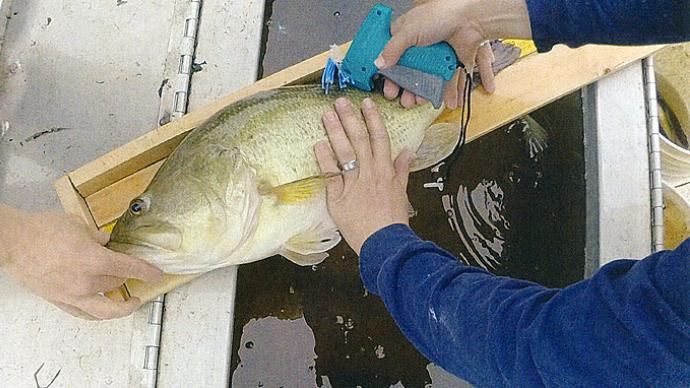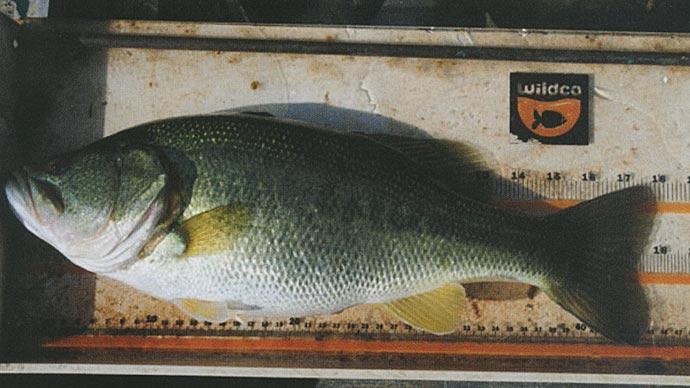
There have been many Pond Boss articles written over the years on bass genetics as it relates to improving the gene pool for growing monster bass. We've discussed selecting genetic strains, harvesting under-performing individuals, and refreshing the genetic stock. However, we rarely get the chance to follow such efforts to fruition.
In a recent edition of my podcast Fish University, which is part of the Natural Resources University podcast series, I had the opportunity to discuss the great state of Texas' Toyota ShareLunker Program. My guest was Tom Lang, the Director of the Texas Freshwater Fisheries Center (TFFC) in Athens, Texas, home to the Program and the production facility for Largemouth Bass in the state.
The Toyota ShareLunker Program embodies many topics we preach in private pond and lake management. It was designed to selectively reproduce the biggest fish so that the fingerling bass produced have the best potential for growing large.
Sound familiar?
It is similar to what our agriculture producers have been doing for millennia. Did you know that an ear of corn today is 1,000 times larger and has 350% more sugar than 9,000 years ago? Peaches are 64 times larger, sweeter, and juicier.
Thanks, science.
The Toyota ShareLunker Program is a partnership between anglers, the Texas Parks and Wildlife Department, and industry sponsors that began in 1986. From January 1 through March 31, when an angler catches a largemouth bass that is 13 pounds or bigger, they can call the ShareLunker hotline (903-681-0550) and donate that fish to the Program. A local biologist response team will come out immediately and secure the fish until TFFC personnel can pick it up and provide a 5-star ride back to the facility in the Toyota ShareLunker Tundra hauling truck. This recently added response team ensures that anglers do not have to wait as long for TPWD to arrive, their prized catch is in the hands of trained biologists sooner, and the fish is in the ideal environment of the TFFC hatchery sooner.
A 13-plus-pound bass is a big fish. There are 29 U.S. states without a state record for largemouth bass that large. To grow that large, a fish needs good genetics, long growing seasons, lots of food, and time—most ShareLunkers average about ten years old. To catch a fish that big is to have one of the best days of your life.
You may ask, "Who would give away their prized fish?" That was a concern, but when the Program kicked off in 1986, Mark Stevenson caught a 17.67-pound new Texas state record bass out of Lake Fork (broken in 1992 by an 18.18-pound ShareLunker for Lake Fork). Mark named the fish Ethel and donated it to the Program as ShareLunker #1. That show of support led other anglers to support the Program as well.
ShareLunkers are always going to be female. Male bass simply don't get that large. So, to ensure that the genes contributed by the male are optimized for growth, TFFC spawns that big girl with a male produced by a previous ShareLunker bass.
A big lady bass will expel about 20,000 eggs. Interestingly, the eggs of a Share-Lunker are larger than regular bass eggs. This suggests that a true genetic advantage goes to the cellular level. It also implies that these larger eggs might have greater investment and, potentially, a greater likelihood of survival.
Once the eggs are spawned, the male fertilizes them, and in the next few months, fingerling bass with a genetic lineage with increased potential to grow exceptionally large are produced. These fingerlings are stocked out to public waterbodies in the hopes of producing bigger bass. Fingerlings are prioritized for the waterbody that produced that big female, so there's more incentive to submit a big fish and ensure the future of your favorite lake.
In the TFFC hatchery, these fish get first-class care, and survival is exceptionally high. There can be some mortality, but more than 95% have survived over the past four years, which includes 100% survival of the big fish in 2022. Likewise, about 80% of the eggs make it to fingerling size at the hatchery, whereas wild fish would be fortunate to get a 0.1% return on investment. Thus, each female can produce 16,000 fingerlings - in the wild, she might make 16 if she's lucky!
Every ShareLunker is genetically tested. Most of these big fish are heavily skewed towards Florida bass genetics, and a few are pure Florida bass. TFFC has retained some pure Florida bass offspring and grown them into adults. Once these fish were available, they converted their Florida bass hatchery to these ShareLunker offspring.
In other words, the Florida largemouth bass stocked in Texas are now descendants of ShareLunkers; all have the potential for greatness. They call them Lonestar Bass. Texas stocks 4-6 million of these Lonestar Bass every year. Assuming half are male, that is 2-3 million potential 13-plus-pound bass for the future.
The Program maximizes the reproduction of these big fish, and their offspring have the potential to grow exceptionally large. So, is it working? Yes, and the results are beginning to show.
Remember that genetic testing can detect the lineage of big fish, which is the Program's product. In other words, new 13-plus pound ShareLunkers can be traced genetically to previous ShareLunkers. ShareLunker #9 is responsible for six generations of ShareLunkers, and five lake record bass can be traced back to that one fish. The lake record bass at Marine Creek Lake in Fort Worth was a descendant of ShareLunker #9 until her sister eclipsed the record from the same spawn. The lake records at Tyler State Park, Lake Nacogdoches, and Coleman City Lake all trace back to #9!
Consistent stocking over more than three decades is beginning to pay dividends. Many of these lakes did not historically grow bass this large before receiving fingerlings produced in the Program. But lake records are being broken, and to date, 75 public waterbodies have now produced a ShareLunker bass!
Anglers that provide their trophy don't leave empty-handed. TFFC will provide them a replica mount of their fish, gear from AFTCO, 6th Sense Lures, and Stanley Jigs, and they are entered into a drawing for a $5,000 Bass Pro Shops gift card. Not to mention the bragging rights of catching a ShareLunker! When spawning is over, that big girl is hauled back to where she was caught, and the angler is invited to release that big girl right where they caught her.
If you are a pondmeister in Texas, you are not entirely excluded. You can provide a ShareLunker from your pond; 20 private waters have provided fish. However, it is a public program, and thus, the fingerlings produced from your pond bass must go to public waters. Of course, your ShareLunker is returned to your pond.
You might ask if all this effort might be pushing the goalposts. Is Texas changing the standards of what constitutes a trophy bass? I asked Tom this question. His response was, "I look forward to having that problem." I must agree with him.
I also asked Tom if the goal is to grow the next world record bass. He quickly answered, "No, it is not. It is not even to grow the next state record. We just want to give people a chance to catch the biggest bass of their life." But I am sure if a record falls, celebrations will ensue.
As for Ethel, once she spawned, Mark Stevenson donated her to the Bass Pro Shops aquarium in Springfield, Missouri, where she lived for another nine years and continued to grow. Millions of visitors viewed Ethel over her lifetime, and when she finally died, Bass Pro Shops held a funeral.
Reprinted with permission from Pond Boss Magazine



